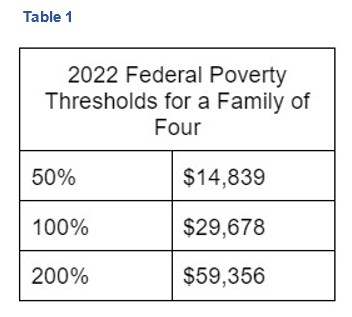Posted on June 11, 2024

By Alena Siddiqui
Data Analyst
For more information on this topic or kids count data, contact Alena at asiddiqui@acnj.org

Poverty is commonly defined as the state of insufficiency or lacking financial resources, goods, and means of support. Poverty thresholds have been used in the United States since 1965, and are based on a basic food diet and adjusted for inflation and family size/composition. Poverty thresholds are not a perfect method of determining who is in poverty because these thresholds are uniform across the nation; however, the cost of living is not. States like New Jersey are known to have a higher cost of living and an income at 200% of the poverty level (about $59,000 for a family of four) is more reflective of a family who may be living paycheck to paycheck in the state.
Table 1 shows the 2022 federal poverty thresholds for a family of four--two adults and two children. A family making less than 100% of the federal poverty level is considered to be living in poverty. In 2022, an estimated 253,875, or 13%, of New Jersey children were living below the federal poverty level, which is less than in 2021 when there were an estimated 284,150, or 14%, of children living in poverty. As seen in Chart 1, the dispersion of children living below the poverty level appears to be more prevalent in the southern part of the state.

Of the 50 states, New Jersey has the second highest median income for households with children, trailing behind Massachusetts by $1,101. The median income for households with children has increased in New Jersey as a whole and numerous counties have seen a large increase according to the American Community Survey data. In 2022, New Jersey’s median income for households with children was $120,874, which is almost $9,000 higher than the previous year. This tells us that many New Jersey families with children are earning more money. In fact, almost all counties, with the exception of Cumberland, have median family incomes higher than $80,000.
New Jersey offers many types of assistance programs designed to help not only families in poverty, but those who may be considered low-income as well. Some of these programs include New Jersey FamilyCare and NJSNAP.
In March 2023, there were 934,905 NJ FamilyCare recipients under age 19 in New Jersey, 49,024 more than the previous year. Children (under 19) in families with incomes up to 355% of the federal poverty level are eligible for the state’s health insurance program. Since January 2023, immigration status is no longer a hindrance for children looking to apply for NJFamilyCare. NJ SNAP (formerly known as Food Stamps) is another program which helps families. There were 343,009 New Jersey children participating in the NJ SNAP program. Most of these children lived in Essex (16%), Hudson (12%), and Passaic (10%) counties. In order to be eligible for NJ SNAP, households must have a monthly income of less than 185% of the federal poverty level, among other requirements.
Chart 1
To learn more about family economic security in the state of New Jersey and by individual counties, please refer to New Jersey Kids Count 2024.

